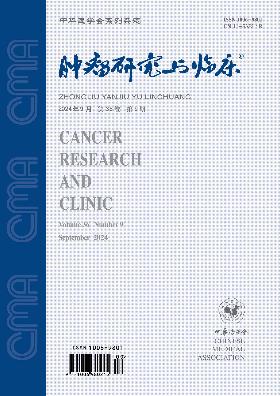叶酸受体阳性循环肿瘤细胞检测对亚细胞肺结节的诊断价值
Q4 Medicine
引用次数: 1
摘要
目的探讨叶酸受体(FR)阳性循环肿瘤细胞(CTC)检测在肺部良恶性(最大直径≤10mm)结节诊断中的价值。方法收集首都医科大学宣武医院2018年7月至12月收治的37例肺结节(胸部CT显示最大直径≤10mm)患者。其中22例经术后病理诊断为早期肺腺癌,15例为肺部良性病变。术前采集这些患者的静脉血样,然后通过新型配体靶向聚合酶链式反应(LT-PCR)检测FR+CTC水平(定义单位为FU/3ml),并使用酶联免疫吸附法检测肿瘤标志物的水平,包括癌胚抗原(CEA)、神经元特异性烯醇化酶(NSE)、细胞角蛋白19片段CYFRA21-1,碳水化合物抗原125(CA125)、CA199、促胃泌素释放肽(pro-GRP)等。使用t检验比较各组之间的测量值。检测试剂盒说明书中描述的CTC值8.70 FU/3ml用作阈值。采用二元逻辑回归分析肺部恶性结节的危险因素。κ一致性检验用于确定通过FR+CTC水平获得的诊断结果与手术切除标本的病理结果的一致性。绘制受试者工作特征曲线(ROC),以评估各指标对良恶性亚单位肺结节诊断的有效性。结果早期癌症患者FR+CTC水平高于良性肺病变患者,差异有统计学意义[(11.0±3.0)FU/3ml与(7.0±3.7)FU/3/ml,t=-3.327,P=0.001],Logistic回归分析表明,高水平FR+CTC是肺恶性结节的危险因素之一(OR=37.333,95%CI 3.994-349.010,P=0.002)。κ说明FR+CTC在用作诊断恶性肺结节的指标时优于CEA、NSE和CYFRA21-1。FR+CTC的曲线下面积(AUC)为0.830(95%CI0.639-0.968),诊断灵敏度和特异性分别为72.7%(95%CI49.6%-88.4%)和93.3%(95%CI66.0%-99.7%)。联合应用FR+CTC、CEA、NSE和CYFRA21-1诊断癌症,AUC、敏感性和特异性分别为0.776(95%CI 0.614-0.938)、86.4%和73.3%。结论FR+CTC检测对肺部良恶性亚单位结节的诊断具有较高价值。关键词:叶酸受体;新生细胞,循环;肺结节;肺肿瘤;亚厘米结节本文章由计算机程序翻译,如有差异,请以英文原文为准。
Diagnostic value of folate receptor-positive circulating tumor cell detection in subcentimeter pulmonary nodules
Objective
To investigate the value of the folate receptor (FR)-positive circulating tumor cell (CTC) detection in the diagnosis of benign and malignant subcentimeter pulmonary nodules(the maximum diameter ≤10 mm).
Methods
Thirty-seven patients with subcentimeter pulmonary nodules (the chest CT showed the maximum diameter was ≤10 mm) in the Xuanwu Hospital of Capital Medical University from July to December 2018 were collected. Among them, 22 cases were diagnosed with early stage lung adenocarcinoma by postoperative pathological diagnosis and another 15 cases were benign lung lesion. Venous blood samples from these patients were collected before surgery and then utilized to detect FR+ CTC level (defined unit as FU/3 ml) by novel ligand-targeted polymerase chain reaction (LT-PCR), and the enzyme-linked immunosorbent assay was used to detect the levels of tumor markers, including carcinoembryonic antigen (CEA), neuron-specific enolase(NSE), cytokeratin 19 fragment CYFRA21-1, carbohydrate antigen 125 (CA125), CA199, pro-gastrin releasing peptide (pro-GRP), etc. The t-test was used to compare the measurement values between the groups. The CTC value 8.70 FU/3 ml described in the detection kit instruction was used as the threshold. The binary logistic regression was used to analyze the risk factors of malignant pulmonary nodules. The kappa consistency test was used to identify the consistency of the diagnosis results obtained by the FR+ CTC level and the pathological results of surgically resected specimens. The receiver operating characteristic curve (ROC) was drawn to evaluate the efficiency of each index for the diagnosis of benign and malignant subcentimeter pulmonary nodules.
Results
The level of FR+ CTC in patients with early stage lung cancer was higher than that in patients with benign lung lesion, and the difference was statistically significant [(11.0±3.0) FU/3 ml vs. (7.0±3.7) FU/3 ml, t=-3.327, P = 0.001]. The level of FR+ CTC was not related to the age, gender and smoking history of patients (all P>0.05). Logistic regression analysis indicated that high-level FR+ CTC was one of the risk factors for malignant pulmonary nodules (OR = 37.333, 95% CI 3.994-349.010, P = 0.002). The kappa consistency test indicated that the level of FR+ CTC used for the diagnosis of lung subcentimeter nodules presented a certain accuracy (κ = 0.627, P < 0.01). ROC illustrated that the FR+ CTC was better than CEA, NSE and CYFRA21-1 when it was used as an indicator for the diagnosis of malignant pulmonary nodules. The area under the curve(AUC) of FR+ CTC was 0.830 (95% CI 0.639-0.968), and the diagnostic sensitivity and specificity were 72.7% (95% CI 49.6%-88.4%) and 93.3% (95% CI 66.0%-99.7%), respectively. When FR+ CTC, CEA, NSE and CYFRA21-1 were combined for lung cancer diagnosis, the AUC, sensitivity and specificity were 0.776 (95% CI 0.614-0.938), 86.4% and 73.3%, respectively.
Conclusion
The detection of FR+ CTC has a high value in the diagnosis of benign and malignant subcentimeter pulmonary nodules.
Key words:
Folate receptor; Neoplastic cells, circulating; Pulmonary nodules; Lung neoplasms; Subcentimeter nodules
求助全文
通过发布文献求助,成功后即可免费获取论文全文。
去求助
来源期刊

肿瘤研究与临床
Medicine-Oncology
CiteScore
0.10
自引率
0.00%
发文量
7737
期刊介绍:
"Cancer Research and Clinic" is a series of magazines of the Chinese Medical Association under the supervision of the National Health Commission and sponsored by the Chinese Medical Association.
It mainly reflects scientific research results and academic trends in the field of malignant tumors. The main columns include monographs, guidelines and consensus, standards and norms, treatises, short treatises, survey reports, reviews, clinical pathology (case) discussions, case reports, etc. The readers are middle- and senior-level medical staff engaged in basic research and clinical work on malignant tumors.
 求助内容:
求助内容: 应助结果提醒方式:
应助结果提醒方式:


